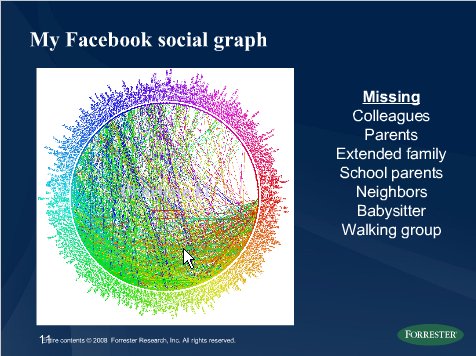Just a small update. Charlene Li has written her own post about the presentation she has given. Definitely worth a read. You can find it over here.
I read a report on a talk Charlene Li gave on the future of social networks. In this presentation she goes through a number of interesting things. A copy of her presentation can be found here.Charlene talks about user profiles, social graphs, identity, social activities and social influence. In essence each of these topics boil down to the same overall theme. Currently, our on-line social activities are scattered around many different services. As a result we have multiple identities, sets of friends, walled gardens between services. She predicts there is a need for a universal identity (one profile across all services), a single social graph (my friends are available through all services) and relevant context across all services when a user performs an action (if I buy a book at Amazons I want to read the reviews of my own friends). She ends her presentation with the idea that social influence might be the most important marketing value in the future.
Read her presentation if you want to get into the details. Charlene knows what she is talking about, so it is good reading.
It got me thinking a bit about this future. To understand the future, we sometimes need to understand the past or present. I assume Charlene is making these predictions based upon the current social networking practice and uses examples such as the platform and social graph wars being fought in different walled garden services like Facebook and other social networks.

When we look at current behaviour there are a number of interesting things to note. Lets look at our on-line friends and interactions first. Charlene uses a fractal like image to describe her current social graph and goes on by saying that half of her social life isn’t even included in that graph. So our relationships are complex.
But I would argue that they are also thin as air. I can have conversations with people around the world I have never seen or will ever meet in real life. It takes zero effort to communicate with these “friends”. But I don’t need to maintain these relationships. I do not need to invest in them. They are virtual, provided to me because it is so easy to get into contact on-line. The cost of having interaction with many on-line friends has dropped to zero. These relationships sometimes provide me fun, interesting information, great conversations. But often they simply are there, untouched, or hardly interactive. The social graph of human beings might have exploded because of the lowered transaction cost to build and maintain it. But I would argue that the value of that social graph is also highly volatile.
I can emerge myself into a social graph with literally thousands of friends, only to hide my real self behind this mass of people. I can be anonymous, an alter ego, a persiflage of myself because it really doesn’t matter either way. There is hardly any investment into such on-line relationships, nor is it expected. I’ll get to the implications of that in a minute.

Here I am
Second, despite of the possibility to have thousands of on-line friends, multiple identities, different services, human behaviour isn’t really equiped at handling all this diversity. In most cases we tend to favour a few roles and identities as well as friends. I currently have one hundred or so followers on Twitter (which is a small number compared to other users), and I follow each of them back. But I do not interact with every one of them. Instead I tend to favour a few, based upon earlier interactions, shared interests, or plain old fun. Think about this for a moment. What do you do when you join a new social service? You immediately look up, or try to import the friends you had on a previous social network right? We might have thousands of on-line relations, but only a few of them really matter to us. We can’t handle the complexity and volatility of too many on-line friends. It is great to have thousands of unknown, far away, on-line friends, but in the end we only invest more effort in a few of them. Nothing wrong with that, as this networking generation has no expectations regarding on-line friendship. Interacting without really getting to know each other is an accepted way of communicating with each other.
What about the future of social networks? I think Charlene is right in predicting that there will be some kind of “standardization” or integration of multiple user identities into some universal identity. The same will happen with social graphs. They are bound to be tied together at some point, creating one big, complex, social graph for each of us.
But the question to me is whether this will happen because the user wants it, or because the advertiser needs it. Just think about that for a second. I’m sure people like Mark Zuckerberg have. They see the social graph as the new marketing pot of gold.
Having access to the most influential beings in any social network. Where influence determines marketing value. Where all relevant personal profile and social graph data is centralised and available for commercial exploitation. It is a marketeers wet dream isn’t it?
ButI said it before, all marketeers are idiots. I have serious doubts that they will understand me in this new ubiquitous social network. They won’t really understand my profile, my interactions. They will have a false illusion that by centralising things, cooking it all into a giant soup bowl, they will get a better grip on their customers. Locking them in, providing them with relevant commercial messages based upon the ingredients of this soup.

But there are at least 2 relevant issues with that assumption.
First of all, you won’t find the real me there. I’m hiding behind thousands of friends, only showing you the public me, a persiflage of real life. You might think that this universal social network will provide you better information than demography does now. Yes, I am 39 years old, married to a lovely wife, I have four kids and I live in the Netherlands. But that really is just a small, public part of me.
As a marketeer, you might even have the illusion that the most influential people in such a network are your target audience. The social networks will battle to get these influential people on board of their network as Charlene puts it. But I doubt it will do marketeers, or users for that matter, that much good.
Second, social networks are primarily there for us to interact with other people. That is the real power of a social network. It isn’t about a social graph, which is a static representation of the connections between people. It is my day to day interactions within that social graph that makes it valuable. And, as I have stated before, advertisement has no value within these interactions. Marketeers are merely trespassers in our on-line conversations.
Does that mean there isn’t any hope for marketeers in this future of social networking? Sure there is. But not within the social network itself or within the interactions that take place in that network. Mark Zuckerberg is right to think that having access to my profile, my interactions, and my social graph is valuable. But the value of having that data lies outside of Facebook or any other social network for that matter. The real value comes only within the context of a user searching or buying something on-line. That is where the data becomes valuable. Why? Because it helps the marketeer to provide me with advertisement that, in itself, has value within my context. I don’t want advertisement in my social interactions. But I do want them when I’m searching or buying stuff. Facebook won’t become the next generation advertisement machine. Facebook and it’s data will merely complement the already successful commercial targeting process that companies like Google and Amazon execute so well.
The future of Social Advertisment lies outside of social networks.


I was pointed to this post by a friend on FriendFeed as he said it compilments the one I had just posted called The Economy of Friending – http://www.winextra.com/2008/03/04/the-economy-of-friending/ .. so out of something I had written that was appreciated by a friend I have now read a post I really enjoyed – made me think and got you a new subscriber. The thing is this only happened because I respect the person who made the link .. for me one of the few times that social networking has proven it’s worth and not a single ad transpired between any of those points 🙂
Thanks for a good thought provoking post.
Pingback: The Cost of Friending and What it Means for Marketing in Social Networks : The Last Podcast
@steven Thanks for your compliment 😉 I read your post too and couldn’t agree more.
In my opinion, marketers shouldn’t try to understand you based on your interactions but rather your intentions, interests and sentiment.
It’s a huge signal/noise ratio problem but the social web (including your blog) represents fertile ground for behavioral analysis and user profiling. Users are providing a lot of information on themselves — the explicit data holds value but implicit data can be much more valuable.
In either case, I agree that the commercial value of social web profiling lies not within the social web experience, but rather as the user moves across the Web.
Hi Alexander, great post. Found you through my Google Reader, and a Mashable link. Rather than idiots, I believe many, not only marketers, have trouble letting go of old, increasingly irrelevant organizing metaphors. As for the creation of value, you are correct – it will always be created at the edge of a network, through interactions between people. Btw, followed you on Twitter!
Pingback: dobedo » Blog Archive » Beyond Free
Pingback: Cudowna reklama online? | AK74 - blog Artura Kurasińskiego (cc) 2007
Pingback: Dlaczego tradycyjny formaty reklamy nie dzia�aj� w sieci? - Sprawny Marketing Forum